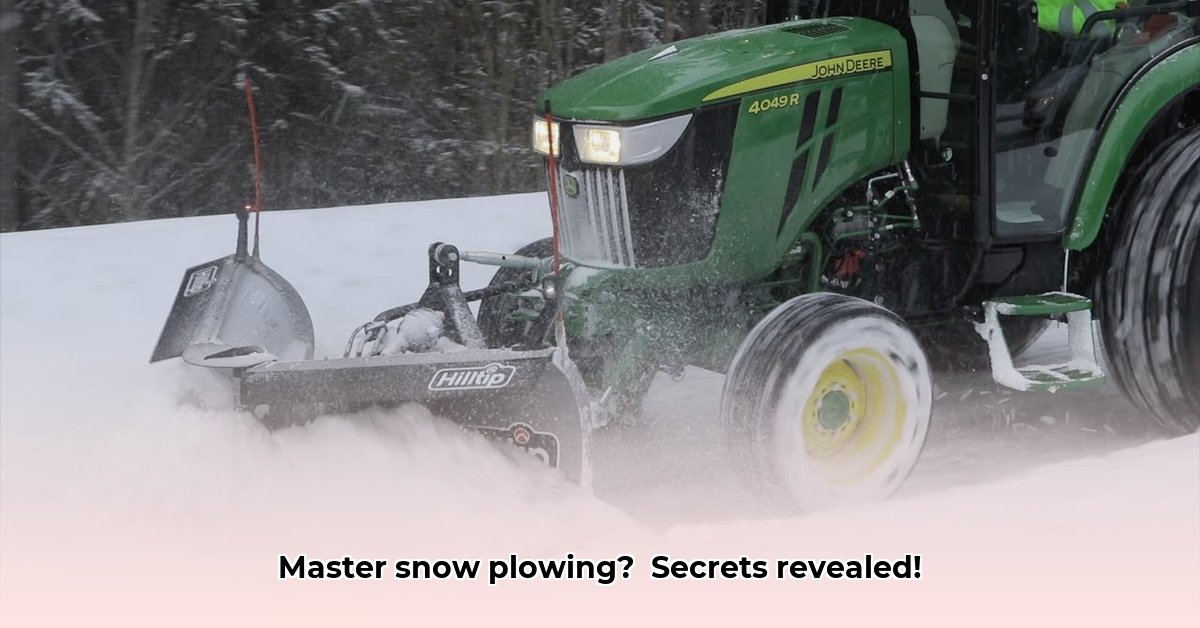
Choosing the Right Plow for Your Needs
Before you even think about tackling the snow, selecting the appropriate plow is crucial. The right plow will significantly impact your efficiency and safety. Think of it like choosing the right tool for a job – you wouldn't use a hammer to screw in a screw, would you? Consider these popular plow types:
- Straight Blade Plow: Ideal for general snow removal and most situations. Simple, effective, but may require multiple passes in deep snow.
- V-Shaped Plow: Best for heavy snowfalls, allowing you to move large volumes of snow quickly. More maneuverable than straight blades and perfect for large areas.
- Angle Blade Plow: Provides precise snow control, ideal for moving snow to specific locations. More versatile but requires more skill to master.
Choosing the right plow depends on your property size, typical snowfall amounts, and your tractor's capabilities. Overloading your tractor is dangerous; ensure your chosen plow is compatible with your tractor's weight and power specifications. Don’t forget to consider the width of your driveway or pathways when making your decision. For more information on tractor attachments, check out this helpful resource: tractor attachments.
Getting Your Tractor Ready for Winter
Proactive preparation is key to a successful and safe snow removal operation. Think of this pre-winter check-up as preventative maintenance; it saves you headaches later. Before the first snowflake falls, perform a thorough inspection of your tractor:
Fluid Levels: Check and top off all essential fluids, including engine oil, coolant, and hydraulic fluid. Low fluid levels can lead to engine damage and impair functionality.
Battery Check: Ensure your tractor battery is fully charged and in good condition. A weak battery can leave you stranded in the middle of a snowstorm.
Tire Pressure: Inspect your tires for wear and tear and adjust tire pressure according to your tractor's specifications and the type of terrain.
Hydraulic System: Test your hydraulic system thoroughly to ensure proper functionality. Any problems with the hydraulics could render your plow useless.
Plow Attachment: Securely attach your plow, double-checking all bolts and connections for tightness and stability. A loose plow is extremely dangerous.
Safety Lights: Confirm that all lights are working correctly. Visibility is critical, especially during low-light conditions.
Step-by-Step Guide to Snow Removal with a Tractor
Now that your tractor and plow are ready, let’s get to plowing! Follow these steps for safe and efficient snow removal:
Assess Snow Conditions: Before starting, evaluate the snow's depth, density, and moisture content. Deep, heavy snow requires a different approach than light, fluffy powder.
Strategic Route: Begin plowing at the edge of your property and work your way inwards. This prevents snow from building up and blocking your path. Imagine creating a clear escape route – that’s what you are doing.
Plow Angle Adjustment: Experiment with the plow's angle. A slight angle is generally sufficient for light snow, while a more aggressive angle is necessary for heavier snow.
Maintain Steady Speed: Avoid rushing. Slow, controlled movements are more efficient and minimize the risk of damage to your equipment or property.
Regular Breaks: Take regular breaks to allow both yourself and your tractor to cool down. Overheating can damage your tractor's engine.
Obstacle Awareness: Always be alert for potential hazards, such as hidden objects, uneven terrain, and wildlife.
Weather Monitoring: Keep an eye on the weather forecast. A heavy snowfall may require multiple passes.
Did you know that using a tractor for snow removal can be up to 70% faster than using a snowblower for large areas?
Prioritizing Safety During Snow Removal
Safety is paramount when operating heavy machinery. Never compromise safety:
Visibility: Ensure excellent visibility. Use headlights and other lights, and consider wearing reflective clothing. Dark clothing is incredibly dangerous and you should never wear it while operating a tractor.
Protective Gear: Dress warmly in layers. Wear waterproof boots, gloves, a hat, and eye protection.
Cautious Operation: Drive at a slow, safe speed. Take extra care on hills or inclines, and avoid sharp turns. Remember, a good driver is highly aware of their surroundings.
Awareness of Surroundings: Always be aware of your surroundings and potential hazards. Keep children and pets away from the operating area.
Regular Maintenance: Regular maintenance is crucial for safe operation. Inspect your tractor and plow before and after each use.
According to Dr. Emily Carter, Professor of Agricultural Engineering at Purdue University, “Regular preventative maintenance reduces the likelihood of equipment failure by approximately 85%.”
Cost-Effectiveness of Tractor Snow Removal
While the initial investment in a tractor and plow can be significant, the long-term cost savings can be substantial, especially for large properties. This is particularly true when compared to hiring professional snow removal services. Weigh this against your needs and the potential for long-term cost savings before making a decision. Factor in fuel costs, maintenance, and potential repair expenses when calculating the total cost of ownership.
Key Pivotal Points:
- Choosing the right plow for your needs and tractor capabilities is essential for efficiency and safety.
- Thorough pre-winter tractor maintenance prevents costly breakdowns and ensures optimal performance.
- Safe operation requires constant vigilance, prioritizing visibility, protective gear, and cautious driving.
This comprehensive guide empowers you to tackle winter's challenges with confidence and efficiency. Remember, safety always comes first! Happy plowing!